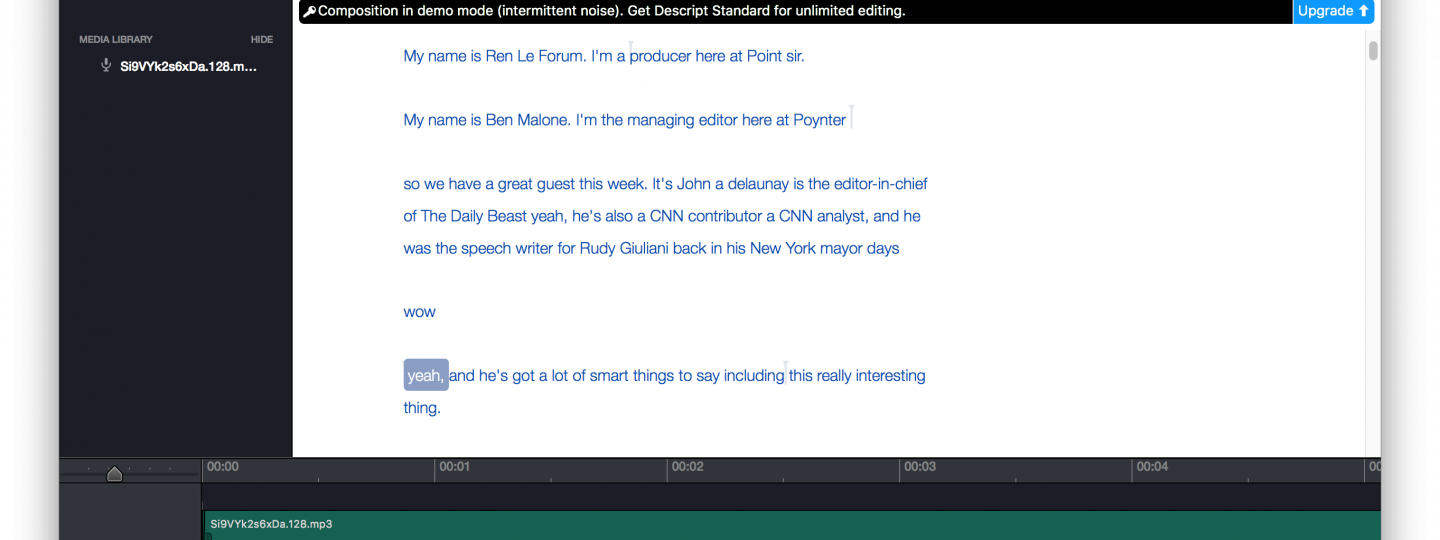It's an understatement to say that podcasting has exploded over the past few years. Though the format has existed for more than a decade, shows like "Serial" and "The Daily" ushered in a golden age of audio.
Podcasts have a low barrier to entry. With a little audio editing knowledge and some free software, almost anyone can make one. But a new tool eliminates that barrier entirely by opening up podcast editing to anyone who knows how to edit text.
Kristen Hare: Hi, Ren! What’s our latest tool and how will it make my life and/or journalism better?
Ren LaForme: Howdy, Kristen! Before we get to that, I have an update about last week’s conversation. We talked about what we could do with our old Storifys since that tool is shutting down and I offered a few solutions.
Some folks from a company called Wakelet reached out to me after that. They have a tool to essentially copy your old Storifys over to their tool in one click. You would still have to go in and re-embed them, but it’s a solid solution. And I hear Wakelet is adding a few extra features soon that should make Storify fans pretty happy, so it’s worth checking out.
Onward! This week, I want to dip back a little bit into the audio transcription game but from a slightly different angle. We talked last year about Happy Scribe, which is a great tool for transcribing interviews. Then I wrote up a big review of a bunch of automatic transcription tools.
But what about if you’re editing the audio itself? That process is still pretty old-school. Have you ever done any editing for a radio or podcast before?
Hare: Not for a podcast or radio, but I have done it for videos and online. It is tedious. Please make it easier.
LaForme: Tedious is an understatement. To edit audio, you have to listen to it over and over and click just the right spot on the waveforms to delete various segments. That’s why I’m so jazzed about this tool called Descript.
Instead of editing the waveforms, Descript transcribes the audio for you using Google Speech. You then edit the text like you would with any text editor and Descript automatically edits the audio to match. I have to say, it feels a lot like magic.
Hare: Oh that sounds like magic. What else should we know about this? Is it free? Any special software or operating systems needed?
LaForme: It’s not free. But they only charge 15 cents per minute of audio transcribed for the “standard” version, which isn’t bad at all. You can upgrade to a “paid” version (I’m a little confused about “free” vs. “standard” when they’re both paid), where you’re only charged seven cents per minute of audio transcribed, plus 10 bucks a month. That version comes with a more robust audio editor. You get 30 minutes of free transcription for whatever version you choose.
No matter the version, you have to download the Descript software. It seemed a little odd to me, because most of the other transcription tools are browser-based, but it worked well.
I uploaded a few test files and it seemed quite accurate. Definitely in line with the other tools I’ve tested. It seemed a lot faster than the others, too. It churned through the 45-minute podcast I uploaded in less than a minute.
Hare: Who do you think this tool is good for? How do you see journalists using it?
LaForme: I’d eat this up if I was still making podcasts. The hardest part of putting those together, for a text person like me, was actually hearing what I was listening to and editing it into something that makes sense. This makes that so easy.
And it has direct exports to Avid, Adobe Audition and a couple other of the more potent audio tools. So you could really use it as a front-end editor for content and then push it to a more robust editor for quality control.
It also has some really great online collaboration tools — you can send a link to others who can then listen to the audio and make comments on it. It’d be great for a group that’s putting together a video or audio project.
Hare: What else should we know about this? Anything you’d tweak or change?
LaForme: It’s a little bit odd, and they address this in their FAQ so I don’t feel too bad, that they launched their first version as a Mac app. They’re working on a full browser version, which is going to be about a million times more helpful for the Windows-based newsrooms out there, aka pretty much all of them.
The security nerds might feel a little trepidation about their file storage procedures, but I’ve certainly seen a lot worse in this realm.
Other than that, it’s hard to complain. Like I said, it has many of the same quirks as the other audio editing tools. But they’re getting better all the time. I’m not personally going to pay the $10 a month to use it but I totally would if I was making podcasts. Ten bucks is going to save them a lot of time.
Descript Need-to-Know
Launched: December 2017
Purpose: Edit audio files by uploading the files and editing the automatically transcribed text. Export to a range of audio editing tools.
Price: 15 cents per minute of audio transcribed for "free" users, or 7 cents per minute of audio transcribed for "standard" users ($10/month)
Platform: Mac only for now. A web-based version is in production.
Editor's note: This is the latest in a series of articles that highlight digital tools for journalists. You can read the others here. Got a tool we should talk about? Let Ren know!







